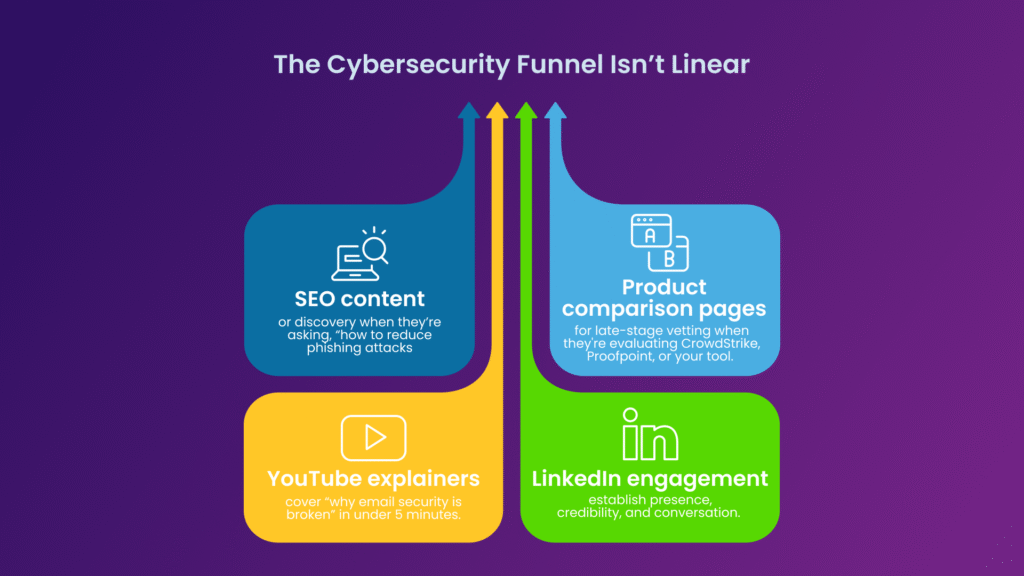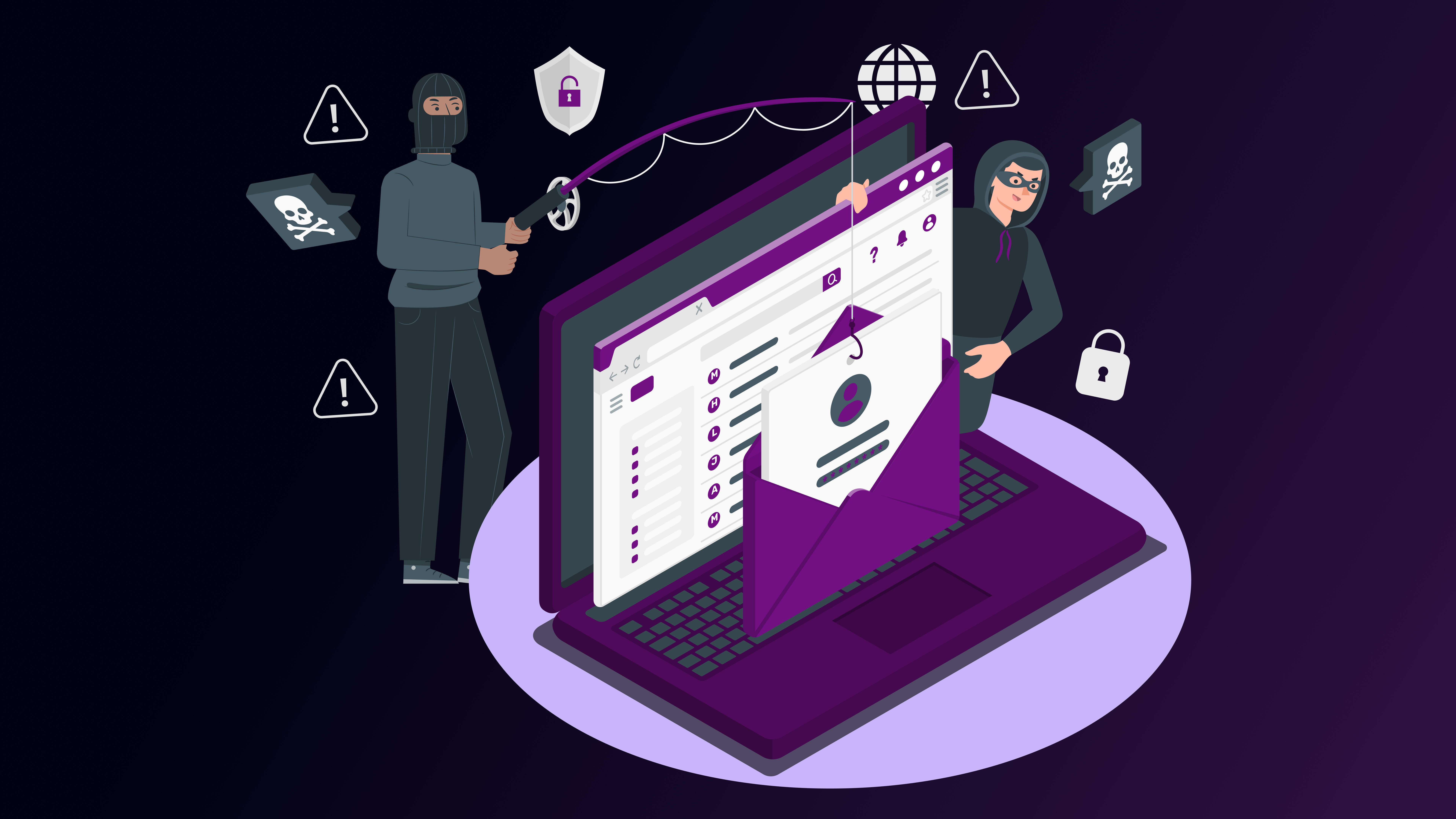If you’ve ever tried hiring a marketing agency to help grow your cybersecurity business, you’ve probably heard some version of this pitch:
“We’ve worked with B2B clients before. We get the tech space.”
Well… they actually don’t. Funny thing is you realize it after you’ve burnt 6 months of cash.
They don’t know what a red team assessment actually involves.
They don’t understand why your email security solution needs to integrate with Microsoft and Google.
They definitely don’t know how CISOs think – or what it takes to earn their trust.
Here’s what most agencies won’t admit:
Cybersecurity marketing isn’t just B2B marketing with a few more acronyms
It’s a niche all on its own – a high-stakes industry where the buyer doesn’t just want to be informed… they want to be reassured.
And that’s where things get tricky.
To market cybersecurity effectively, you don’t just need someone who can write a blog or set up a LinkedIn campaign.
You need a partner who:
- Tracks the latest industry threats, tools, and trends like their life depends on it
- Speaks to compliance and risk with the nuance it deserves
- Knows how to structure content for both the engineer and the executive
- Understands that fear is not a strategy — and neither is fluff
- Can balance long-term trust-building with short-term pipeline momentum
And above all – someone who isn’t scared to say:
“We’re in this with you. If it doesn’t work, we don’t win either.”
That’s why at Digi-tx, we ditched the bloated retainer-first agency model.
We believe cybersecurity companies need more than services – they need strategic risk-sharing partners who grow with them.
That means more technical knowledge paired with lower upfront cost, shared accountability, and real outcomes. We build content and campaigns that show your value to the people who need to see it – and we only win if you do.
Now, we’re not going to bore you with generic tactics like “optimize your homepage” or “write more blogs.” Instead, we’re pulling back the curtain and sharing the real secrets – the kind that most cybersecurity marketing agencies won’t talk about.
Because you deserve a lot better than recycled playbooks and surface-level work. So, let’s get started.
The 5 secrets of cybersecurity marketing services that no one will tell you
1. Cybersecurity Marketers Need to Know Security – Not Just SEO
Let’s be blunt. Most marketing agencies might know what a keyword is, but ask them what “lateral movement” means or why EDR matters over AV, and you’ll get blank stares.
That’s because 90% of cybersecurity marketing is still treated like general B2B SaaS. But it’s not. It’s technical, it’s nuanced, and most importantly, it’s deeply connected to risk. When you’re selling email security, red teaming, GRC automation or vulnerability scanning, your prospects don’t just want value propositions – they want validation.
If your content confuses an engineer, it dies in the Slack thread. If it doesn’t speak to the CISO’s priorities, it gets archived. This is why most “copy-paste” SEO content doesn’t convert – it sounds like it’s written by someone who just Googled “SOC 2.”
At Digi-tx, we want to flip this script. Our team dives deep into the product and the threat space before we even write the first line of a landing page. We train ourselves on how each client’s solution really works, how it’s deployed, and how it’s different – before deciding what needs to be said. Because if your agency can’t understand your tech, they can’t communicate your value.
2. If You Don’t Speak the Industry’s Language, the Platform Doesn’t Matter
LinkedIn. YouTube. Email. Webinars.
They are great platforms – but irrelevant, if your messaging is bland, generic, or technically off the mark. The cybersecurity community is allergic to fluff. They can sniff out fakeness like a SIEM detects anomalies.
And the most important bit – “you can’t make things up for long”
CISOs don’t want to hear that your tool “leverages AI to protect emails.”
They want to know if you detect polymorphic malware and phishing variants faster than Microsoft Defender.
They want to know if your product passes their zero trust architecture checks.
They want to know if it integrates with Splunk, AWS, and Okta.
If your content doesn’t speak their language – if it doesn’t use the acronyms, patterns, and frameworks they live and breathe – you’re not building trust. You’re wasting attention.
At Digi-tx, we don’t push content to a platform until it’s reflecting clarity, technical fluency, and audience fit. Because you can get the reach, but the real deal is to resonate with the audience.
3. The Cybersecurity Funnel Isn’t Linear – and Sometimes, It Doesn’t Exist
Forget the classic marketing funnel. CISOs don’t operate in neat sequences.
They may find your founder’s LinkedIn post today, read one of your blogs six weeks later, then engage a third-party analyst to validate your tech, before even considering a sales call.
Or they might just hop on a quick call, right after that cold email.
Some of your best buyers will never fill out your lead-magnet form. They lurk. They evaluate silently. They loop in teams. They revisit anonymously – multiple times.
Some, on the other hand, are urgently looking for a solution and might just want to see some solid proof of concept before jumping on call with you.

That’s why cybersecurity marketing needs a multi-path structure:
- SEO content for discovery when they’re asking, “how to reduce phishing attacks in regulated industries.”
- Product comparison pages for late-stage vetting when they’re evaluating CrowdStrike, Proofpoint, or your tool.
- YouTube explainers that cover “why email security is broken” in under 5 minutes.
- LinkedIn engagement to establish presence, credibility, and conversation.
This is exactly why we built our cybersecurity SEO playbook around real-world decision journeys – and why most of our clients’ leads don’t come from CTAs. They come from confidence.
4. Fear Isn’t the Enemy – It’s the Strongest Hook (When Used Right)
In most B2B marketing, fear is discouraged. But in cybersecurity, fear – real, grounded, justifiable concern – is part of the conversation.
The threat landscape is real. Supply chain attacks, zero-day exploits, deepfakes, ransomware-as-a-service – they’re not hypothetical. So don’t shy away from showing the stakes, as long as you’re being helpful, not alarmist. Share real alarming facts that your audience worry about every day, but don’t speak out in public.
For example:
- Don’t say: “Your business is at constant risk.”
- Say: “82% of phishing attacks now bypass Microsoft Defender’s default settings – here’s what CISOs are doing about it.”
Ground your messaging in actual verifiable facts and numbers that they can trust. Using the correct language to reflect a certain degree of fear, you can garner a lot of trust.
This kind of messaging requires careful calibration, and that’s why cybersecurity marketing is a specialist game. The fine balanced scare with subtlety combination works perfectly for an audience that plays with fire everyday.
5. Anonymity Isn’t a Bug – It’s a Feature
What’s the biggest challenge in marketing cybersecurity products?
No one wants to be named. No one wants to publicly admit that they had vulnerabilities. You can’t publish client logos, and you can’t write in-depth case studies because of NDAs and data sensitivity.
But that doesn’t mean you can’t build proof.
We use anonymized storytelling and pattern recognition:
- “A cloud-native logistics firm saw a 67% drop in attack attempts within 60 days.”
- “A European fintech firm adopted X framework and achieved audit readiness in half the expected time.”
At Digi-tx, we believe in showing off your good work and we prefer doing it extremely anonymously. And it’s part of why our cybersecurity content converts. It’s about showing that you have dealt with the problems and your solutions save the day for your clients.
Cybersecurity Marketing Services Require More Than Marketing
While marketing cybersecurity, you’re not marketing a feature. You’re not even marketing a product. You’re asking for trust. Asking for confidence for risk mitigation and resilience.
And if your marketing partner doesn’t get that – you’re losing before you start.
That’s why we created Digi-tx.
We combine domain fluency, organic marketing expertise, and a risk-aligned pricing model that grows when you grow.
No fluff. No vague reports. No PDFs that no one reads. Just honest, strategic execution – with skin in the game.
Want to see how that works?





